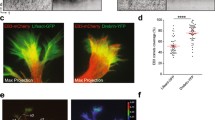Abstract
The actin-binding protein vinculin is a major constituent of focal adhesion, but its role in neuronal development is poorly understood. We found that vinculin deletion in mouse neocortical neurons attenuated axon growth both in vitro and in vivo. Using functional mutants, we found that expression of a constitutively active vinculin significantly enhanced axon growth while the head-neck domain had an inhibitory effect. Interestingly, we found that vinculin-talin interaction was dispensable for axon growth and neuronal migration. Strikingly, expression of the tail domain delayed migration, increased branching, and stunted axon. Inhibition of the Arp2/3 complex or abolishing the tail domain interaction with actin completely reversed the branching phenotype caused by tail domain expression without affecting axon length. Super-resolution microscopy showed increased mobility of actin in tail domain expressing neurons. Our results provide novel insights into the role of vinculin and its functional domains in regulating neuronal migration and axon growth.







Similar content being viewed by others
Data availability
All materials are available on request.
Code availability
Not applicable.
References
Dent EW, Gupton SL, Gertler FB (2011) The growth cone cytoskeleton in axon outgrowth and guidance. Cold Spring Harb Perspect Biol 3(3):a001800
Lian G, Sheen VL (2015) Cytoskeletal proteins in cortical development and disease: actin associated proteins in periventricular heterotopia. Front Cell Neurosci 9:99
Luo L (2002) Actin cytoskeleton regulation in neuronal morphogenesis and structural plasticity. Annu Rev Cell Dev Biol 18:601–635
Ishikawa R, Kohama K (2007) Actin-binding proteins in nerve cell growth cones. J Pharmacol Sci 105:6–11
Dent EW et al (2007) Filopodia are required for cortical neurite initiation. Nat Cell Biol 9:1347–1359
Kwiatkowski AV et al (2007) Ena/VASP is required for neuritogenesis in the developing cortex. Neuron 56:441–455
Letourneau PC, Pech IV, Rogers SL, Palm SL, McCarthy JB, Furcht LT (1988) Growth cone migration across extracellular matrix components depends on integrin, but migration across glioma cells does not. J Neurosci Res 21:286–297
Mierke CT (2009) The role of vinculin in the regulation of the mechanical properties of cells. Cell Biochem Biophys 53:115–126
Romero S, Le Clainche C, Gautreau AM (2020) Actin polymerisation downstream of integrins: signaling pathways and mechanotransduction. Biochem J 477:1–21
Calderwood DA, Yan B, de Pereda JM, Alvarez BG, Fujioka Y, Liddington RC, Ginsberg MH (2002) The phosphotyrosine binding-like domain of talin activates integrins. J Biol Chem 277:21749–21758
Garcia-Alvarez B, de Pereda JM, Calderwood DA, Ulmer TS, Critchley D, Campbell ID, Ginsberg MH, Liddington RC (2003) Structural determinants of integrin recognition by talin. Mol Cell 11:49–58
Atherton P et al (2015) Vinculin controls talin engagement with the actomyosin machinery. Nat Commun 6:10038
Ziegler WH, Liddington RC, Critchley DR (2006) The structure and regulation of vinculin. Trends Cell Biol 16:453–460
Johnson RP, Craig SW (1994) An intramolecular association between the head and tail domains of vinculin modulates talin binding. J Biol Chem 269:12611–12619
Johnson RP, Craig SW (1995) F-actin binding site masked by the intramolecular association of vinculin head and tail domains. Nature 373:261–264
Bakolitsa C et al (2004) Structural basis for vinculin activation at sites of cell adhesion. Nature 430:583–586
Borgon RA, Vonrhein C, Bricogne G, Bois PR, Izard T (2004) Crystal structure of human vinculin. Structure 12:1189–1197
Letourneau PC, Shattuck TA (1989) Distribution and possible interactions of actin-associated proteins and cell adhesion molecules of nerve growth cones. Development 105:505–519
Burridge K, Mangeat P (1984) An interaction between vinculin and talin. Nature 308:744–746
Menkel AR, Kroemker M, Bubeck P, Ronsiek M, Nikolai G, Jockusch BM (1994) Characterisation of an F-actin-binding domain in the cytoskeletal protein vinculin. J Cell Biol 126:1231–1240
Xu W, Baribault H, Adamson ED (1998) Vinculin knockout results in heart and brain defects during embryonic development. Development 125:327–337
Xu W, Coll JL, Adamson ED (1998) Rescue of the mutant phenotype by reexpression of full-length vinculin in null F9 cells; effects on cell locomotion by domain deleted vinculin. J Cell Sci 111(Pt 11):1535–1544
Demali KA (2004) Vinculin–a dynamic regulator of cell adhesion. Trends Biochem Sci 29:565–567
Thievessen I et al (2013) Vinculin-actin interaction couples actin retrograde flow to focal adhesions, but is dispensable for focal adhesion growth. J Cell Biol 202:163–177
Coll JL, Ben-Ze’ev A, Ezzell RM, Rodriguez Fernandez JL, Baribault H, Oshima RG, Adamson ED (1995) Targeted disruption of vinculin genes in F9 and embryonic stem cells changes cell morphology, adhesion, and locomotion. Proc Natl Acad Sci U S A 92:9161–9165
Varnum-Finney B, Reichardt LF (1994) Vinculin-deficient PC12 cell lines extend unstable lamellipodia and filopodia and have a reduced rate of neurite outgrowth. J Cell Biol 127:1071–1084
Sydor AM, Su AL, Wang FS, Xu A, Jay DG (1996) Talin and vinculin play distinct roles in filopodial motility in the neuronal growth cone. J Cell Biol 134:1197–1207
Li CL, Sathyamurthy A, Oldenborg A, Tank D, Ramanan N (2014) SRF phosphorylation by glycogen synthase kinase-3 promotes axon growth in hippocampal neurons. J Neurosci 34:4027–4042
Nadarajah B, Parnavelas JG (2002) Modes of neuronal migration in the developing cerebral cortex. Nat Rev Neurosci 3:423–432
Humphries JD, Wang P, Streuli C, Geiger B, Humphries MJ, Ballestrem C (2007) Vinculin controls focal adhesion formation by direct interactions with talin and actin. J Cell Biol 179:1043–1057
Cohen DM, Chen H, Johnson RP, Choudhury B, Craig SW (2005) Two distinct head-tail interfaces cooperate to suppress activation of vinculin by talin. J Biol Chem 280:17109–17117
Cohen DM, Kutscher B, Chen H, Murphy DB, Craig SW (2006) A conformational switch in vinculin drives formation and dynamics of a talin-vinculin complex at focal adhesions. J Biol Chem 281:16006–16015
Chandrasekar I, Stradal TE, Holt MR, Entschladen F, Jockusch BM, Ziegler WH (2005) Vinculin acts as a sensor in lipid regulation of adhesion-site turnover. J Cell Sci 118:1461–1472
Ferrere A, Vitalis T, Gingras H, Gaspar P, Cases O (2006) Expression of Cux-1 and Cux-2 in the developing somatosensory cortex of normal and barrel-defective mice. Anat Rec A Discov Mol Cell Evol Biol 288:158–165
Atherton P, Stutchbury B, Jethwa D, Ballestrem C (2016) Mechanosensitive components of integrin adhesions: role of vinculin. Exp Cell Res 343:21–27
Roca-Cusachs P, del Rio A, Puklin-Faucher E, Gauthier NC, Biais N, Sheetz MP (2013) Integrin-dependent force transmission to the extracellular matrix by alpha-actinin triggers adhesion maturation. Proc Natl Acad Sci USA 110:E1361–E1370
Le S et al (2017) Mechanotransmission and Mechanosensing of Human alpha-Actinin 1. Cell Rep 21:2714–2723
Mierke CT, Kollmannsberger P, Zitterbart DP, Smith J, Fabry B, Goldmann WH (2008) Mechano-coupling and regulation of contractility by the vinculin tail domain. Biophys J 94:661–670
Craig AM, Banker G (1994) Neuronal polarity. Annu Rev Neurosci 17:267–310
Bays JL, DeMali KA (2017) Vinculin in cell-cell and cell-matrix adhesions. Cell Mol Life Sci 74:2999–3009
Stevens GR, Zhang C, Berg MM, Lambert MP, Barber K, Cantallops I, Routtenberg A, Klein WL (1996) CNS neuronal focal adhesion kinase forms clusters that co-localise with vinculin. J Neurosci Res 46:445–455
Le Clainche C, Dwivedi SP, Didry D, Carlier MF (2010) Vinculin is a dually regulated actin filament barbed end-capping and side-binding protein. J Biol Chem 285:23420–23432
Blanchoin L, Pollard TD, Mullins RD (2000) Interactions of ADF/cofilin, Arp2/3 complex, capping protein and profilin in remodeling of branched actin filament networks. Curr Biol 10:1273–1282
Mullins RD, Heuser JA, Pollard TD (1998) The interaction of Arp2/3 complex with actin: nucleation, high affinity pointed end capping, and formation of branching networks of filaments. Proc Natl Acad Sci USA 95:6181–6186
Sturner, T. et al. (2019). Transient localisation of the Arp2/3 complex initiates neuronal dendrite branching in vivo. Development 146(7)
Hetrick B, Han MS, Helgeson LA, Nolen BJ (2013) Small molecules CK-666 and CK-869 inhibit actin-related protein 2/3 complex by blocking an activating conformational change. Chem Biol 20:701–712
Huttelmaier S, Bubeck P, Rudiger M, Jockusch BM (1997) Characterisation of two F-actin-binding and oligomerisation sites in the cell-contact protein vinculin. Eur J Biochem 247:1136–1142
Thompson PM et al (2014) Identification of an actin binding surface on vinculin that mediates mechanical cell and focal adhesion properties. Structure 22:697–706
Riedl J et al (2008) Lifeact: a versatile marker to visualise F-actin. Nat Methods 5:605–607
Zhang M et al (2012) Rational design of true monomeric and bright photoactivatable fluorescent proteins. Nat Methods 9:727–729
Wozniak MA, Modzelewska K, Kwong L, Keely PJ (2004) Focal adhesion regulation of cell behavior. Biochim Biophys Acta 1692:103–119
De Pascalis C, Etienne-Manneville S (2017) Single and collective cell migration: the mechanics of adhesions. Mol Biol Cell 28:1833–1846
Carisey A, Ballestrem C (2011) Vinculin, an adapter protein in control of cell adhesion signalling. Eur J Cell Biol 90:157–163
Ezzell RM, Goldmann WH, Wang N, Parashurama N, Ingber DE (1997) Vinculin promotes cell spreading by mechanically coupling integrins to the cytoskeleton. Exp Cell Res 231:14–26
Carisey A et al (2013) Vinculin regulates the recruitment and release of core focal adhesion proteins in a force-dependent manner. Curr Biol 23:271–281
Ziegler WH, Gingras AR, Critchley DR, Emsley J (2008) Integrin connections to the cytoskeleton through talin and vinculin. Biochem Soc Trans 36:235–239
Nair D, Hosy E, Petersen JD, Constals A, Giannone G, Choquet D, Sibarita JB (2013) Super-resolution imaging reveals that AMPA receptors inside synapses are dynamically organised in nanodomains regulated by PSD95. J Neurosci 33:13204–13224
Acknowledgements
We thank the microscopy facility and the Central Animal Facility in the division of biological sciences for confocal imaging and animal care, respectively.
Funding
This work was supported by the Department of Biotechnology (DBT)-IISc Partnership Program (N.R. and D.N.), Department of Biotechnology Genomics Engineering Taskforce (N.R. and D.N.), STAR program grant (D.N.), Indian Institute of Science Eminence Program, and University Grants Commission, India (D.N.). P.M. was supported by a fellowship from Council for Scientific and Industrial Research. V.B. was supported by a fellowship from the University Grants Commission, India.
Author information
Authors and Affiliations
Contributions
NR conceived of the project and designed the experiments. PM performed all the experiments and analysed the data; VB and DN performed the super-resolution microscopy experiments and analysed the data. NR wrote the manuscript, and all authors commented on previous versions of the manuscript. All authors read and approved the final manuscript.
Corresponding author
Ethics declarations
Conflict of interest
The authors declare that they have no conflict of interest.
Ethics approval
All the procedures in this study were performed according to the rules and guidelines declared in the Compendium of CPCSEA 2018 by the Committee for the Purpose of Control and Supervision of Experimental Animals (CPCSEA), Ministry of Fisheries, Animal Husbandry and Dairying, India. The research protocol was approved by the Institutional Animal Ethics Committee (IAEC) of the Indian Institute of Science (Project No. CAF/Ethics/516/2016), allowing the use of animals for in vitro and in vivo studies.
Consent to participate
Not applicable.
Additional information
Publisher's Note
Springer Nature remains neutral with regard to jurisdictional claims in published maps and institutional affiliations.
Supplementary Information
Below is the link to the electronic supplementary material.
Rights and permissions
About this article
Cite this article
Mandal, P., Belapurkar, V., Nair, D. et al. Vinculin-mediated axon growth requires interaction with actin but not talin in mouse neocortical neurons. Cell. Mol. Life Sci. 78, 5807–5826 (2021). https://doi.org/10.1007/s00018-021-03879-7
Received:
Revised:
Accepted:
Published:
Issue Date:
DOI: https://doi.org/10.1007/s00018-021-03879-7




